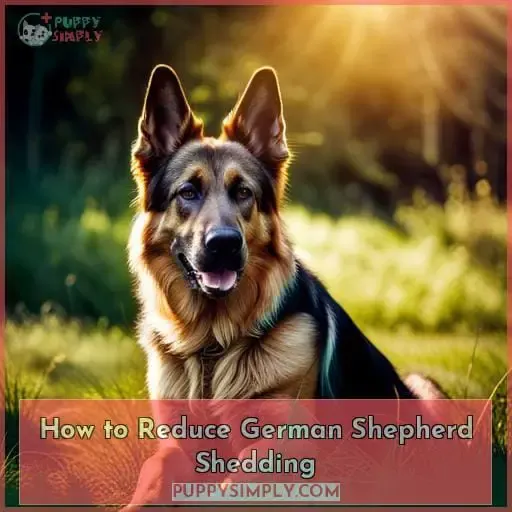This site is supported by our readers. We may earn a commission, at no cost to you, if you purchase through links.
 If you’re a German Shepherd parent, you’re already familiar with your pup’s excessive shedding.
If you’re a German Shepherd parent, you’re already familiar with your pup’s excessive shedding.
Their double fur coat and annual shedding cycles mean you’re constantly vacuuming and lint-rolling.
But it doesn’t have to be that way.
Learn how to reduce German Shepherd shedding with simple tips and tricks that will keep your home fur-free.
Table Of Contents
Key Takeaways
- German Shepherds have a double coat that sheds heavily during seasonal changes to regulate body temperature.
- Regular grooming, proper nutrition, and minimizing skin irritation can help manage excessive shedding.
- Strategies like vacuuming frequently, using furniture covers, and brushing regularly can help control loose fur in the home.
- German Shepherds require significant exercise, training, space, and allergy management consideration before bringing one home.
Do German Shepherds Shed?
Yes, German Shepherds do shed, and they shed a lot.
This is due to their double fur coat, consisting of a wooly undercoat and longer topcoat, which goes through annual shedding cycles.
Managing all this fur can be a challenge for owners not prepared for the amount of vacuuming and grooming required.
Double Fur Coat
Your German Shepherd’s double fur coat is largely to blame for all that excessive shedding.
- The topcoat repels dirt and moisture.
- The soft undercoat provides insulation.
This combination undergoes heavy seasonal shedding.
Shedding keeps the coat healthy but requires diligent grooming.
Annual Shedding Cycles
Your double-coated GSD goes through heavy seasonal shedding cycles each year as the seasons change.
During shedding seasons in spring and fall, excess fur gets removed to make room for new fur growth suited to the changing weather.
To manage the fur tufts around your home during this time, brush frequently and vacuum diligently.
Stick to a healthy diet and schedule seasonal deshedding groomings.
When Do German Shepherds Shed the Most?
You’re dealing with the heaviest shedding during fall and spring when your German Shepherd blows their undercoat.
This seasonal shedding is triggered by changes in daylight rather than temperature.
Make use of undercoat rakes and deshedding tools to remove the loose hair during these periods.
Additionally, the omega-3 fatty acids found in fish oils and some high-quality dog foods will help promote a healthy coat.
Monitoring your dog’s diet is key, as poor nutrition can exacerbate shedding issues.
While climate doesn’t directly impact the shedding cycle, keeping your dog comfortable year-round will reduce stress and its effects on their coat.
Consistent grooming is vital for managing the inevitable increase in fur.
Why Do German Shepherds Shed So Much?
German shepherds shed a lot because of their thick double-layered coats, which help protect them from weather and seasonal changes.
This double coat is made up of a soft, thick undercoat below a thicker, flatter topcoat.
This coat configuration keeps them comfortable in hot and cold temperatures but also means they drop significant amounts of fur.
Their heavy seasonal shedding is triggered by changes in daylight exposure, which signals the dog’s body to blow the undercoat to make room for new fur growth.
Excessive shedding can also indicate underlying health issues like stress, skin irritation, or poor nutrition.
Following proper grooming techniques, monitoring their diet, and providing a comfortable environment can help manage seasonal shedding.
How to Reduce German Shepherd Shedding
To reduce shedding in your German Shepherd, there are three key areas to focus on:
- Brushing: Regular brushing helps remove loose fur and prevents it from spreading throughout your home.
- Bathing: Bathing with a high-quality shampoo keeps the coat healthy and minimizes shedding.
- Diet: Providing a balanced diet rich in essential nutrients can promote better skin health and reduce excessive shedding.
Brushing
Using a quality slicker brush helps remove the loose topcoat and undercoat before it can be spread around your home.
Regular brushing year-round, focusing on areas prone to tangles, keeps your German Shepherd’s coat healthy while capturing shed hair.
Brush against hair growth direction, lifting up hair to get to the undercoat.
Follow with strokes in the direction of hair growth to remove loose hair.
Setting a weekly brushing routine, more often during heavy sheds, is key to managing fur in your home.
Bathing
When bathing your German Shepherd:
- Use a moisturizing shampoo and conditioner to protect their skin and coat while removing loose fur.
- Gently bathe them every 6-8 weeks with a high-quality shampoo formulated for double coats to preserve healthy skin oils.
- Thoroughly rinse and dry their dense undercoat after baths.
- Regular gentle bathing improves coat hygiene, minimizing excessive shedding throughout the year.
Diet
Give your dog omega-3s and antioxidants to nourish skin and fur health.
A nutritionally balanced diet with omega-3 fatty acids from fish, flaxseed, or other oils benefits your German Shepherd’s skin and coat.
Ensure access to clean drinking water, as dehydration exacerbates shedding.
In moderation, incorporate healthy human foods like chicken, vegetables, and fruits.
Combine with regular brushing and bathing.
When grooming techniques reduce loose hairs trapped in the dense undercoat.
Managing German Shepherd Fur at Home
You’ll need to vacuum frequently and invest in furniture covers to manage your German Shepherd’s shedding fur at home.
The loose fur will embed itself everywhere without diligent vacuuming.
Washable covers for your couch, bed, and car will help protect your belongings from embedded fur.
Vacuuming
After brushing and bathing your German Shepherd, you’ll want to start vacuuming frequently to manage the fur shed around your home.
Effective vacuuming techniques for pet hair cleanup and shedding control include:
- Use a vacuum with strong suction and specialized tools.
- Vacuum at least twice per week.
- Focus on fabric surfaces like couches.
- Wash vacuum filters often.
- Use lint rollers on clothing.
Furniture Covers
Since vacuuming helps manage loose fur, you should also use furniture covers on chairs, sofas, and beds to protect surfaces where your German Shepherd likes to lounge.
Opt for stylish covers in pet-friendly fabrics to shield furniture while complementing your decor.
Regularly remove and launder covers, incorporating cleaning strategies for pet hair.
Decorative throws also defend furniture in high-traffic areas from dirt, damage, and fur.
Is a German Shepherd Right for You?
By now, you’re probably wondering if living with this level of dog fur is really for you after all that vacuuming and laundering.
Before getting a German Shepherd, carefully consider:
- Their energetic temperament
- Extensive exercise needs
- Training commitment
- Required living space
- Potential allergy triggers
German Shepherds are working dogs that require at least 2 hours of vigorous daily activity to prevent boredom and destructive behaviors.
Their loyal and protective temperament makes them wonderful family companions, but they demand extensive training and socialization when young.
Their double coats also produce lots of dander that can aggravate allergies.
Ensure you can meet a German Shepherd’s demands for space, activity, training, and grooming before bringing one home.
Frequently Asked Questions (FAQs)
What are the best vacuum cleaners for homes with German Shepherds?
When choosing a vacuum for a German Shepherd home, you’ll want one with strong suction to handle all the fur.
Look for models with special attachments like brushes, hoses, and HEPA filters designed specifically for pet hair removal and dander control.
Emptying canisters frequently also helps maintain suction power.
How often should I bathe my German Shepherd?
You should bathe your German Shepherd every 6-8 weeks.
Use a mild shampoo made for dogs.
Bathing too often can dry out their skin and coat.
Regular brushing between baths helps keep their fur and skin healthy.
What type of brush is best for grooming a German Shepherd?
You’ll want a slicker brush or undercoat rake to groom your German Shepherd.
These tools are specially designed to penetrate their double coat and remove loose hair before it sheds all over your digs.
Regular brushing stimulates the skin, distributes natural oils, and prevents matting in that lush coat of theirs.
Should I give my German Shepherd fish oil supplements?
Yes, you should give your German Shepherd fish oil supplements.
They’re full of omega-3 fatty acids that support skin and coat health.
Regular dosing helps:
- Moisturize skin
- Reduce flakiness and shedding
- Make the fur shiny and soft
Choose a reputable brand approved for dogs.
Is it safe to shave my German Shepherd’s coat?
Shaving your German Shepherd’s coat is not recommended.
It can disrupt their natural cooling and insulation system.
Their double-layered coat serves important purposes:
- Protecting against sunburn
- Regulating body temperature
Conclusion
Alas, your loyal German Shepherd’s lush coat unleashes tufts of fur.
Yet, consistent brushing, baths, and diet adjustments can temper the shedding.
As their doting owner, simply adopt a vacuuming regimen and furnish covers against the enduring fibers.
Their companionship makes German Shepherds treasured, despite the sweeping required.
Rest assured, a small effort on your behalf lets you revel in their glorious company shedding-free.











